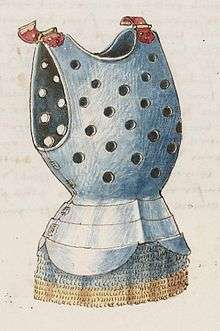Chausses

Chausses (/ˈʃoʊs/; French: [ʃos]) are armour for the legs, usually made from mail. They could extend to the knee or cover the entire leg. Chausses were the standard type of metal leg armour during most of the European Middle Ages. Chausses offered flexible protection that was effective against slashing weapons. However, the wearer still felt the full force of crushing blows.
Reinforcing plates called poleyns began to supplement mail armour in the 13th century. One of the first locations to see this protection was the knee. But because most leg armor had to be pulled on from the foot, rather than snapped on such as a breastplate, a chausse might have been considered to be worn on the foot. Steel shin plates called schynbalds came into use during the final quarter of the century. Unlike greaves, schynbalds protected only the front of the lower leg. These early plate additions were worn over chausses and held in place with leather straps. Chausses became obsolete in the 14th century as plate armour developed.
Chausses were also worn as a woollen legging with layers, as part of civilian dress, and as a gamboissed (padded) garment for chain mail.
The old French word chausse, meaning stocking, survives only in modern French as the stem of the words chaussure (shoe) and chaussette (sock) and in the tongue-twister:
Les chausses sèches de l’archiduchesse
Sont elles sèches ou archisèches?
which today is often misunderstood as "les chaussettes de l’archiduchesse".
External links
- Arador Armour Library guide to constructing replica chausses
- A General History of Armor
